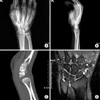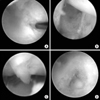Abstract
Purpose
To evaluate the usefulness of wrist arthroscopic examination in patient with persistent pain after the triquetral dorsal chip fracture and also to determine its relationship with TFCC injury in the triquetral dorsal chip fracture patient manifesting persistent pain.
Materials and Methods
This study is based on six cases presenting persistent pain in the ulnar aspect after the triqeutral posterior cord fracture that were treated conservatively. Wrist arthroscopy was carried out for all six cases. All were preoperatively and postoperatively evaluated using VAS pain scale, grip power, ulnar grind test, Kleinman shearing test and lunotriquetral ballottment test.
Results
Preoperatively, ulnar grind test yielded positive results in all six cases, Kleiman shearing test proved positive in three cases and lunotriquetral ballottment test yielded positive result in one case. In the arthroscopic findings, synovitis and TFCC injury were detected in all cases, and based on Palmer classification of TFCC injury, type IA was determined in five cases and type ID in one case. Arthroscopic TFCC partial resection and synovectomy were carried out. VAS pain scale improved from an average 8 points preoperatively to 3 points postoperatively. The difference of grip power between the normal and the other side improved from average of 15 lb preoperatively to 5 lb postoperatively. Based on postoperatively physical examination at 6 weeks, all cases yielded negative results in the ulnar grind test and Kleiman shearing test.
Figures and Tables
Fig. 1
Plain x-ray (A, B) and CT (C) of a 45-year-old man show chip fracture of triquetrum and MRI (D) shows TFCC injury.

References
1. Abboud JA, Beredjiklian PK, Bozentka DJ. Nonunion of a triquetral body fracture. A case report. J Bone Joint Surg Am. 2003; 85:2441–2444.
3. Botte MJ, Gelberman RH. Fractures of the carpus, excluding the scaphoid. Hand Clin. 1987; 3:149–161.

4. Bryan RS, Dobyns JH. Fractures of the carpal bones other than lunate or navicular. Clin Orthop Relat Res. 1980; 149:107–111.
6. Failla JM, Amadio PC. Recognition and treatment of uncommon carpal fractures. Hand Clin. 1988; 4:469–476.

7. Garcia-Elias M. Dorsal fractures of the triquetrum. avulsion or compression fractures? J Hand Surg Am. 1987; 12:266–268.
9. Levy M, Fischel RE, Stern GM, Goldberg I. Chip fractures of the os triquetrum: the mechanism of injury. J Bone Joint Surg Br. 1979; 61:355–357.

10. Schubert H. Triquetrum fracture. Can Fam Physician. 2000; 46:70–71.
11. Shah MA, Viegas SF. Fractures of the carpal bones excluding the scaphoid. J Am Soc Surg Hand. 2002; 2:129–140.





 PDF
PDF ePub
ePub Citation
Citation Print
Print






 XML Download
XML Download